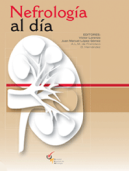It is widely recognized that chronic kidney disease (CKD) is an increasingly important global public health problem.1,2 Its high prevalence, clinical impact and substantial economic burden have placed it at the center of international healthcare debate.2,3 In response, international organizations and national scientific societies are promoting strategies to improve early detection, diagnosis and comprehensive management of CKD, even beyond strictly nephrological settings.2,4 This approach is supported by robust evidence that it is possible to markedly reduce not only CKD progression but also associated renal and cardiovascular morbidity and mortality.5
Despite this, several studies have shown that neither the detection nor the initial management of CKD is yet optimal. Some studies have reported that recognition of CKD through its coding in the electronic health record (EHR) is associated with slower CKD progression and greater use of evidence-based cardiorenal-protective therapies.6 Therefore, appropriate CKD coding is one of the strategies to prevent or delay renal disease progression. In our regional plan for Mejora de la Asistencia Nefrológica (M.A.N.) in the Barcelonès Nord and Maresme Health Area (≈550,000 inhabitants; 320,000 adults >40 years), based on the ETC concept2 (STAGE, TREAT, CODE, CONSULT) and closely aligned with the results of the REVEAL-CKD study,6 we identified the predominant use of code N18.9—equivalent to “unspecified CKD”—as the most frequent nephrological diagnosis recorded in EHRs (Fig. 1). This previously undescribed situation merits special attention, as other healthcare regions may be doing the same thing unnoticed.
Although N18.9 represents a substantial step forward because it enables assessment of cardiorenal-protective therapeutic adequacy (i.e., when N18.9 is linked to renin–angiotensin system blockade, sodium–glucose cotransporter-2 inhibitors, nonsteroidal mineralocorticoid receptor antagonists), its reach is incomplete. The diagnosis of unspecified CKD (N18.9), by failing to reflect the true disease stage, limits clinical decision-making and subsequent monitoring, and it hinders both population-level and individualized (personalized) risk stratification – renal and vascular – based on estimated glomerular filtration rate within current and future predictive tools/algorithms.7 Moreover, such diagnoses compromise longitudinal follow-up unless easy access to laboratory data is available. Such access would allow inclusion of albuminuria, a key biomarker for optimizing therapy and improving the accuracy of renal and/or cardiovascular risk prediction.7
Even so, we note with optimism several important advances, such as a rise in measurements of albuminuria (114,702; 168,931; and 218,652 in 2022, 2023, and 2024, respectively), more identification of previously undiagnosed cases (8020 new cases between 2023 and January 2025), and growth in stage-specific CKD coding (Table 1).
Distribution by codes (ICD-10) for new diagnoses across different periods in the Northern Metropolitan Area of Barcelona (in bold, an example of increased specific coding—N18.3—and a decrease in N18.9).
| CKD diagnosis (N 18) | 2018−2022 | 2023-jan2025 |
|---|---|---|
| Stage G1 (N18.1) | 0.01% | 0.06% |
| Stage G2 (N18.2) | 0.19% | 4.39% |
| Stage G3 (N18.3) | 1.05% | 13.93% |
| Stage G4 (N18.4) | 0.11% | 2.21% |
| Stage G5 (N18.5) | 0.05% | 0.20% |
| Stage G5D (N18.6) | 0.05% | 0.07% |
| Unspecified CKD (N18.9) | 98.53% | 79.09% |
CKD: chronic kidney disease.
However, while identifying risk factors, recognizing diagnostic criteria and ensuring the essential (any) coding of CKD are important steps toward more efficient care, it is important to stress that CKD prevalence is still likely underestimated. Data from clinical laboratories support this: two out of every three patients with CKD identified through laboratory analytics had no diagnostic coding at all.8 This gap between clinical reality and administrative record/coding has direct consequences for prevention and therapeutic management.5,9 We believe there is room for improvement in CKD diagnosis, prognosis and treatment through the active involvement of all stakeholders in the healthcare system. This participation includes not only hospital specialists, family and community medicine specialists, primary-care and hospital (and even community) nursing and pharmacy, but also—prominently—clinical laboratories and their associated information systems.10 Both can make highly significant contributions by enabling automated alerts, facilitating coding, providing more accurate risk calculations and optimizing treatments on an individualized basis, thanks to the development of necessary clinical decision-support systems.5,9,10 In addition, artificial intelligence, by applying predictive models, could help identify patients at higher risk of progression, automatically detect patients with CKD, determine their stage and even recognize cases of unrecognized CKD as well as those falling under the potential new concept of “pre-CKD”.5
FundingNo funding.
The authors declare no conflicts of interest related to this topic.








